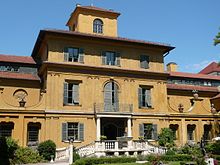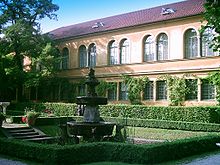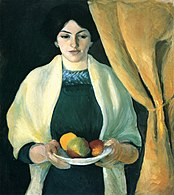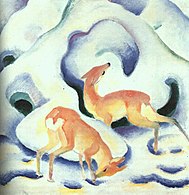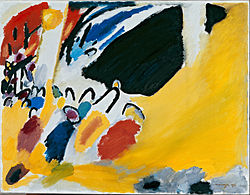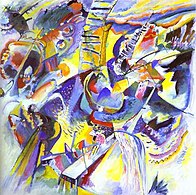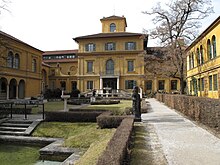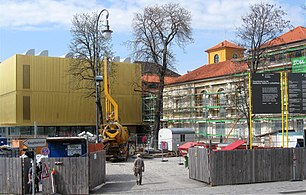Municipal gallery in the Lenbachhaus
The Städtische Galerie im Lenbachhaus is an art museum in the Bavarian capital, Munich . It is housed in the Lenbachpalais, the listed villa of the "painter prince" Franz von Lenbach at Luisenstrasse 33 in the Munich art area ( Maxvorstadt ). The villa was built between 1887 and 1891 according to plans by Gabriel von Seidl and extended by Hans Grässel from 1927 to 1929 and by Heinrich Volbehr and Rudolf Thönessen from 1969 to 1972 . Some rooms have been preserved in their original state and can be viewed as part of an exhibition visit.
It was opened in 1929. From 2009 until it reopened on May 8, 2013, the Lenbachhaus was completely renovated and an extension by the architectural office Foster + Partners was added.
The director of the museum is Matthias Mühling . He took over the office at the turn of the year 2013/14. Before that, the museum u. a. Headed by Hans Konrad Röthel (1956–1971), Erika Hanfstaengl (1971/72 provisional), Michael Petzet (1972–1974), Armin Second (1974–1990) and Helmut Friedel (1990–2013).
The lenbachhaus is part of the Munich Art Quarter in the Maxvorstadt . Here, 18 museums and exhibition halls as well as around 40 galleries and six universities can be reached on foot.
The museum belongs to the MuSeenLandschaft Expressionism , together with the Museum of Fantasy (“Buchheim Museum”) in Bernried am Starnberger See , the Franz Marc Museum in Kochel am See , the Museum Penzberg and the Murnau Castle Museum .
collection
Permanent collection / exhibition
The museum began with the municipal collection of painters working in Munich, especially from the 18th and 19th centuries. The city council tended to collect not or not yet academic artists, while the Bavarian State Painting Collections acquired works by painters from the Bavarian Academy of Fine Arts for the Alte and Neue Pinakothek . The Lenbachhaus owns works by Jan Polack , Christoph Schwartz , George Desmarées ( Countess Holstein 1754), Wilhelm von Kobell , Johann Georg von Dillis , Carl Rottmann , Carl Spitzweg , Eduard Schleich , Carl Theodor von Piloty , Franz von Stuck , Franz von Lenbach , Friedrich August von Kaulbach , Wilhelm Leibl , Wilhelm Trübner and Hans Thoma . The 19th century painting from the so-called Munich School can be seen in the north wing. Members of the Munich Secession founded in 1892 , such as Lovis Corinth , Max Slevogt , Fritz von Uhde and Emilie von Hallavanya, are also on display.
In 2012, the Munich Christoph Heilmann Foundation and the Städtische Galerie im Lenbachhaus agreed to work closely together; around a hundred works from the foundation were given to the Lenbachhaus. In addition to the Munich School, the Dresden Romanticism and the Berlin and Düsseldorf School are now also shown in characteristic individual examples. The connection with the Barbizon painters in France , which can be shown for the first time, is particularly important . The Lenbachhaus now has a major work by Gustave Courbet , who first exhibited in Munich in 1851.
The Lenbachhaus owes its world fame to the unique collection of works by the group Der Blaue Reiter with numerous pictures by Alexej Jawlensky , Wassily Kandinsky , Gabriele Münter , Franz Marc , August Macke , Marianne von Werefkin and Paul Klee . In 1957 Gabriele Münter transferred her collection to the Lenbachhaus.
In addition, works of the New Objectivity with works by Christian Schad , Rudolf Schlichter and others can be seen.
Since 1979 the Lenbachhaus has also been buying contemporary art that is only indirectly connected to Munich. Central pieces are the environment show your wound by Joseph Beuys , which became the center of a Beuys collection from the Lothar Schirmer collection . Joseph Beuys' bathtub is also part of this collection . In 1996 the atlas , the autobiographical collection of sketches and materials from Gerhard Richter , was acquired. 2015 came The shop of Hans-Peter Feldmann added, around which the contemporary art under the theme So one thing I must have been rearranged.
The Lenbachhaus owns 28,000 works of art (as of 2016). Of the works that were created up to 1900, only one percent was done by women. If you take into account all works up to the end of World War II, you get a share of six percent, from 1946 to 2015 the stock increased slightly to eleven percent.
Possession of Nazi-looted art
A key point of the Washington Declaration is the restitution of Nazi-looted art . Subsequently, in October 1999, the Culture Committee of the City of Munich decided to support research into Jewish art in the city's museums. The Lenbachhaus also conducts provenance research on works that were created before 1945 and entered the collection after 1933. However, until 2009 there was only one part-time employee available for this research. As of 2009 there were two returns of paintings (2003: Slevogt “Trabrennen in Ruhleben” and 2009: Kanoldt “Kreuzjoch”). As part of the packaging of files before the general renovation of the museum, these were increasingly evaluated for the history of acquisitions. In 2012 three works on paper, in 2016 a bundle of eight works on paper from the 19th century (ex Siegfried Lämmle) and in 2019 a bundle of 16 drawings by Alfred Kubin were returned to the heirs. The Lenbachhaus then bought back the paintings by Slevogt and Kanoldt and the Lämmle bundle from the heirs.
Since 1992, the heirs have been involved in a legal dispute with the city of Munich over the publication of Paul Klee's swamp legend . In 2013 negotiations began, which in 2017 led to an agreement, according to which the picture remained in the possession of the Lenbachhaus after a monetary payment. The dispute over the painting Das Bunte Leben , which is considered to be one of Wassily Kandinsky's main works, attracted national attention and was not decided as of early 2020.
Temporary exhibitions
Changing exhibitions take place in some of the rooms. Since the 1970s, the museum began to present essential trends and artists of the international contemporary art scene in its exhibitions and to collect current art. With its new acquisitions, the museum focuses on works by individual artists in order to present them in groups of works. An important acquisition in 1980 was the installation show your wound by Joseph Beuys .
Installed rooms and groups of works by u. a. Franz Ackermann , Dennis Adams , Christian Boltanski , James Coleman , Lovis Corinth , Thomas Demand , Ólafur Elíasson , Cerith Wyn Evans , Valie Export , Dan Flavin , Günther Förg , Günther Fruhtrunk , Rupprecht Geiger , Isa Genzken , Liam Gillick , Katharina Grosse , Michael Heizer , Andy Hope 1930 (Andreas Hofer), Jenny Holzer , Stephan Huber , Leiko Ikemura , Asger Jorn , Ellsworth Kelly , Anselm Kiefer , Alfred Kohler , Michaela Melian , Gerhard Merz , Maurizio Nannucci , Roman Opalka , Sigmar Polke , Arnulf Rainer , Maria Lassnig , Gerhard Richter , Michael Sailstorfer , Richard Serra , Katharina Sieverding , Andy Warhol , Lawrence Weiner , Wiener Aktionisten and Martin Wöhrl .
The exhibition Sheela Gowda . It .. Matters had to be opened exclusively online for the first time due to the COVID-19 pandemic and can only be viewed on the internet until the museum reopens .
- Some works of art in the collection
Lovis Corinth
self-portrait with skeleton , 1896Franz von Stuck
Salome , 1906August Macke
Portrait with Apples , 1909. The painting shows Elisabeth Macke.Franz Marc
Grazing Horses I , 1910Franz Marc
Blue Horse I , 1911Wassily Kandinsky
Murnau with Church I , 1910
History of the house
Franz von Lenbach's villa
The place where Franz von Lenbach had his villa built was deliberately chosen by him. Directly opposite the classicist Königsplatz with the Propylaea, he created a residence that he wanted to turn into a center of art in Munich. “I intend to build a palace that will overshadow what has been there; the powerful centers of European great art should be connected there with the present ”- said Lenbach in a letter in 1885. The art patron Adolf Friedrich von Schack , the poet Paul Heyse and other artists and art lovers had settled in the neighborhood .
The villa, which he designed together with the architect Gabriel von Seidl , had an L-shaped floor plan, with a studio building on Brienner Strasse, which was completed in 1888, and the main building, which was completed in 1890. A garden divided by fountains was laid out in front of the two buildings. The building and garden, a late bloom of historicism , are largely modeled on the Italian Renaissance, with many decorative elements based on ancient models. It is possible that Lenbach was also influenced by the residence of Peter Paul Rubens in Antwerp, which he had visited in 1877.
The rich interior decoration included ancient sculptures, medieval paintings, tapestries and carpets, but also copies of ancient works of art. In 1892 the decommissioned Chancellor Otto von Bismarck received the ovations from the Munich population from the balcony of the villa.
In 1900 the studio and main building were connected to one another by a harmoniously inserted intermediate wing.
Establishment and growth of the municipal picture gallery
Franz von Lenbach died in 1904. His widow Charlotte ( Lolo ) von Lenbach sold the house to the city of Munich in 1924. After the negotiations were concluded, she donated a large number of works of art from the inventory of the house to the city. These pictures, and an extensive inventory of Lenbach's paintings, formed the basis for a new urban gallery.
One year after the villa was bought, the city made a sum of money available for the purchase of further works of art, which doubled in the following years. The city had the architect Hans Grässel build another wing of the building, the north wing opposite the studio wing. Grässel decided on a restrained, historicizing design language, adapted to the style of the other building wings. In 1929 the new Lenbachhaus was opened to the public.
Development after the Second World War
Large parts of the house were destroyed in the final years of the war in 1944/1945. After a quick reconstruction, exhibitions could be shown again in the north wing in 1947. In 1952 the interior of the studio building was renewed, and then the skylight halls in the northwest were restored.
On February 19, 1957, on her 80th birthday, Gabriele Münter donated a large part of the life's work of her partner Wassily Kandinsky to the city : more than 90 oil paintings, more than 330 watercolors and drawings, sketchbooks, reverse glass paintings, as well as most of his graphic works . There were also 25 paintings, many drawings and graphics by Münter himself, as well as a collection of photographs by the artist couple and their friends. In addition, many works by artist friends such as Alexej von Jawlensky , Franz Marc , August Macke and Marianne von Werefkin were part of the donation. In one fell swoop, the house became a museum of world renown.
Further pictures by Macke, Jawlensky, Marc and Jean-Bloé Niestlé came into the gallery's possession in 1965 through the Bernhard Koehler Foundation . With the funds of the Gabriele Münter and Johannes Eichner Foundations, additional works by the main representatives of the Blue Rider and classical modernism could be purchased in the following years .
In 1971 the Kubin archive of the Hamburg collector Kurt Otte was purchased. In addition to works by Alfred Kubin , it contains extensive correspondence with avant-garde artists. 1969–1972 an extension was created in order to be able to present the strongly grown collection appropriately.
In 1996, some rooms in the center of the first floor in the central building were restored. With precious fabric wallpapers, wooden ceilings and dark pictures, they convey an impression of Lenbach's decorative art in their black and red - and an impression of the era from which the artists of the budding modernism wanted to break away.
Engineering

In 1994 the possibilities of the gallery in the Lenbachhaus were significantly expanded with the opening of the art building. The spacious exhibition area is located in a previously unused part of the mezzanine floor of the Königsplatz underground station very close to the Lenbachhaus and is used for large temporary exhibitions, mostly modern or the latest art.
When the underground subway station was built, an empty space of the same size was left above the station. The 110-meter-long, slightly curved room, divided into two areas by a row of central columns, was expanded into a branch of the Lenbachhaus between 1992 and 1994 by the architects Kiessler + Partner (Munich) on behalf of the City of Munich. The previously closed front sides were given shop windows to the escalators of the underground station. From the mezzanine floor of the underground station, visitors enter the foyer of the Kunstbau and from there via a ramp leading down to the exhibition space. A freight elevator was installed on the neighboring property of a municipal vocational school to transport the works of art. The atmosphere of the exclusively artificially illuminated exhibition space is determined by the raw concrete surfaces of the supports and the ceiling in combination with a maple parquet floor and white wall shells, behind which the duct system of the ventilation technology is hidden. An accent in the structure of the exhibition space is the round room for multimedia presentations, which is accessible via a staircase and which appears to float in the middle of the western area.
The artificial structure was awarded the “ BDA Prize Bavaria” in 1995 as a “timeless architectural work” .
cube
The Lenbachhaus cube was opened in the Petuelpark in mid-2005 . In the cube, art magazines, free exhibition rooms and academy classes had the quarterly opportunity until the beginning of 2011 to curate this exhibition room at the invitation of the Lenbachhaus and to create an accompanying program.
Complete renovation and extension
The Städtische Galerie im Lenbachhaus was closed from the end of February 2009 to May 2013 due to extensive renovation and conversion work. Exhibitions continued to take place in the Kunstbau and Kubus. In 2009 work also began on an extension by the British architects Foster + Partners . It also contains a lobby that functions as a new reception area for the collection and exhibition rooms.
The Lenbachhaus is one of the first museums to be illuminated exclusively with light-emitting diodes and daylight. The artificial light enables daylight to be imitated as well as light bulbs. The lighting was funded by the BMBF with two million euros.
Placement program
The educational program of the Städtische Galerie im Lenbachhaus and the Kunstbau is carried out in cooperation with the Munich Adult Education Center, the Museum Education Center and KUKI - Art for Children.
Movies
- Museum check with Markus Brock : Lenbachhaus Munich. Synopsis ( memento from March 23, 2017 in the Internet Archive ) by 3sat . First broadcast: December 15, 2013
- The savior of the “Blue Rider”. Bayerischer Rundfunk , 12 min., Germany 2017 ( online ). A film by Sandra Wiest that shows how pictures by Kandinsky came to the Lenbachhaus thanks to Gabriele Münter .
See also
literature
- Helmut Friedel (Hrsg.): Municipal gallery in the Lenbachhaus and Kunstbau Munich. Prestel, Munich 1995, ISBN 978-3-7913-1466-2 .
- Helmut Friedel, Ulrich Wilmes (ed.): The memory opens its gates - The art of the present in the Lenbachhaus Munich. Hatje Cantz, Ostfildern 2000, ISBN 3-7757-0889-8 .
- Helmut Friedel (Ed.): From the late Middle Ages to the New Objectivity - the paintings in the Lenbachhaus Munich. Deutscher Kunstverlag, Munich 2009, ISBN 978-3-422-06850-6 .
- Helmut Friedel, Annegret Hoberg (ed.): The Blue Rider in the Lenbachhaus. Prestel, Munich 2013, ISBN 978-3-7913-5311-1 .
- Helmut Friedel, Matthias Mühling (Hrsg.): The Lenbachhaus book: history, architecture, collections. Schirmer / Mosel, Munich 2013, ISBN 978-3-8296-0645-5 .
Web links
Individual evidence
- ↑ General renovation and new building by Foster + Partners , Lenbachhaus.de, accessed on March 20, 2019.
- ↑ Mühling becomes the new director . Süddeutsche.de. December 19, 2012. Retrieved July 16, 2013.
- ↑ Art area. Retrieved July 8, 2019 .
- ↑ MuSeenLandschaft Expressionism. Retrieved July 8, 2019 .
- ^ Lenbachhaus: Joseph Beuys , 2013
- ^ Lenbachhaus: Gerhard Richter Atlas , 2013
- ↑ Lenbachhaus: I must have a thing like this , 2015, accessed on March 20, 2019.
- ↑ a b c Figures according to information from the Munich Department of Culture; Heiner Effern: Munich favor history. The city museums mainly buy works by male artists, but a CSU city council now wants to change that. In: Süddeutsche Zeitung , No. 62, March 15, 2016, p. R1.
- ↑ a b c Kulturreferat: Städtische Galerie im Lenbachhaus; Research into Jewish art possession in German museums. Fourth interim report. (PDF) In: www.ris-muenchen.de. May 7, 2009, accessed February 20, 2020 .
- ↑ a b provenance research. In: www.lenbachhaus.de. Retrieved February 20, 2020 .
- ↑ Swamp legend by Paul Klee. In: www.lenbachhaus.de. Retrieved February 20, 2020 .
- ↑ Bernhard Schulz: Final chapter of a neverending story. In: www.tagesspiegel.de. July 27, 2017, accessed February 20, 2020 .
- ↑ Swantje Karich: The dispute over Kandinsky's main work has escalated. In: www.welt.de. March 7, 2017, accessed February 20, 2020 .
- ↑ Roberta De Righi: Cow dung from Groebenzell. In: www.abendzeitung-muenchen.de. March 30, 2020, accessed April 8, 2020 .
- ^ Friedel: Lenbachhaus Munich. P. 5.
- ^ Winner of the BDA Prize Bavaria 1995 - Artificial construction at Königsplatz in Munich. In: Bund Deutscher Architekten Bundesverband. Retrieved February 4, 2020 .
- ↑ exhibition rearview , lenbachhaus.de, accessed on March 20 of 2019.
- ↑ Lenbachhauses project on the Foster + Partners website (en)
- ^ Museum Education Center
- ↑ KUKI - Art for Children
Coordinates: 48 ° 8 ′ 49 ″ N , 11 ° 33 ′ 49 ″ E
